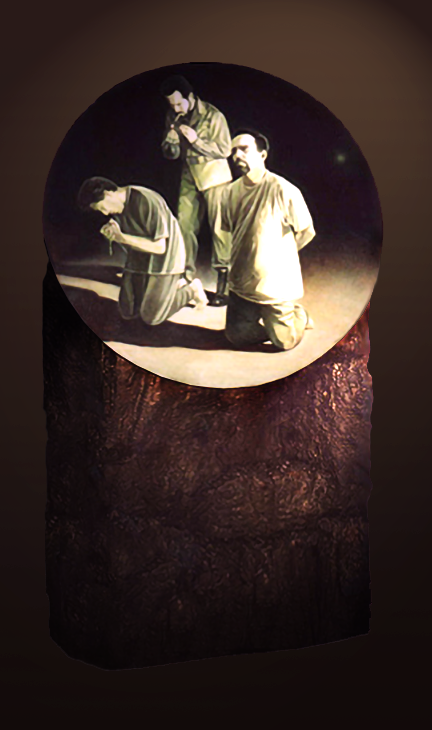
|

|

|

|
 |
||
|
|
The installation was set up so that the first thing seen by the viewer was a painting of three figures set on a free-standing rectangular stone block. The dark stone is a symbol of a sacrificial altar. On the ground before the stone, as if dripping from the painting, were drops of blood. The three figures in the painting represent an executioner and his two victims -the innocent and the oppressor. One of the victims, holding a crucifix, is saying his last prayer; the other prisoner simply awaits his fate; the executioner -a soldier- calmly lights a cigarette to kill time.
The scene is taking place in the middle of the night; harsh illumination provided by the lamps of a vehicle. While no weapon is visible, the sense of impending doom becomes obvious to the viewer who was forced to be a witness to the scene as if looking through the night-scope of a rifle -hence, the round shape of the paintings. The execution was being viewed clandestine from afar, because to be a witness was to invite death.
 |
||
|
|
After studying the painting of the execution that's about to take place, the viewer's attention would shift to the front of the box, which was painted to resemble the front page of the English Edition of a Latin American Newspaper. This front page was 6 ft. wide x 8 ft. high. Printed on this page were articles written in satire designed to engage the interest of the viewer -who now becomes a reader. The articles are inter-connecting stories that relate to the events presented in the installation. What was taking place in the proceeding painting, the identity of the victims and the circumstances that precipitated these actions, began to be revealed.
 |
||
|
|
After having read the articles, the viewer walks through the paper (a door opens on the cover) into a dark room dimly illuminated by the red glow of a small wall-lamp. The door has always been there but barely visible because the articles of the newspaper have been printed over it. Once this door is closed, the viewer, who now becomes a silent participant (by witnessing the truth behind the story), is isolated in this dark space. Below the red lamp, are instructions telling the viewer to pickup a pair of earphones that are hanging from the wall and to put them on (the box is designed for two participants, two earphones are available). Then the viewer is instructed to look through a peephole and listen.
 |
||
|
|
What the participant sees through the peephole is a three-dimensional image of the three figures from the painting. One of the prisoners (the priest) has been executed, and now the executioner has a gun pointed to back of the head of the other prisoner. The image was static but the lighting of the scene kept changing colors cued to a testimonial narrative now being played. Three voices, those of the two victims and the wife of one of the victims, tell the story of their ordeal: arrest, imprisonment, torture and execution. Sound effects enhanced the narrative.
When the narrative ends (3 minutes of audio), the lights deem to black and then suddenly the flash of a gun shot illuminates the darkness as the final prisoner is executed. Silence. Now the viewer/witness exits the enclosure through a back door to wrestle with his thoughts. But before exiting, he is confronted with a mirror in which the following inscription had been etched:
George Orwell, Nineteen Eighty-Four, p. 211
 |
||
|
|
One final image awaited the viewer after the exit: a painting of the aftermath of the execution. This painting followed the format of the first; a circle over a stone. It completed the narrative of the story. In this final image, the bodies of the victims have been unceremoniously dumped into a ditch. The executioner calmly lights another cigarette, and walks away. But it is in this image that the most disquieting commentary in the art piece is made. One of the victims was wearing a T-shirt with a
This installation was also supplemented with a printed handout explaining: What are human rights, Why should we care about human rights; and, three things you can do to help stop human rights abuses. Following its initial exhibition in Montpelier, Vermont, in 1999, I exhibited